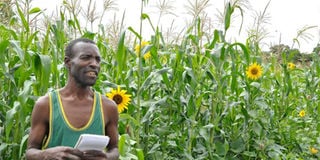Inter-cropping maize with sunflower reduces damage

A farmer displays maize intercropped with sunflower . file PHOTO.
What you need to know:
Single and double row methods of sunflower-maize intercrop are planted at a spacing of 75 centimetres by 30 centimetres, writes Japhet Ruto.
Farmers who target off season green maize market may save up to 10 per cent lost to birds besides improving soil fertility in their farms by intercropping maize with sunflower.
Something different
Intercropping is defined simply as growing two or more crop types on one field. The practice of intercropping has actually been around since farming began. Modernisation of farming equipment has changed our farming practices into what they are today, which is largely mono-cropping.
Mono-cropping is planting only one crop on a field that was adapted with the intention of maximising the amount of seeds you could plant on one field and in a shorter period of time.
Benefits of Intercropping
Better yield
Intercropping offers greater financial returns for a farmer. Even if you are growing some produce for your own family or just as part of a hobby, you will have multiple types of produce, which is always a nice outcome. Intercropping will help farmers to use the same land available and yield more as well as diversify the produce. This generates more income for the farmer without really taking up any major expenditure. The infrastructure available or the land used remains the same.
Insurance
Intercropping can be the insurance that farmers need, especially when the region is vulnerable to extreme weather. Drought, torrential rain and various other weather elements can affect the yield of a given year or season. Having diverse crops allows the farmer to have some income even if the primary crop is damaged or doesn’t yield as much as expected.
Optimum use of soils
Intercropping makes the most of the available soil. When anything is grown on a farmland, the crop tends to absorb as much water and nutrients as it needs. There could be more nutrients in the soil under the crops and around. This soil and more specifically the nutrients is used, by the different varieties of crops. Intercropping also averts soil runoff and can prevent the growth of weeds.
Good for primary crops
Intercropping is good for the primary crops. The secondary crops can provide shelter and even protect the primary crops. Intercropping also allows you to grow cash crops or any crop that will actually supplement the primary crop in some way.
How to do it
“Prepare the land in mid-February for early planting in March during the long rainy season. As for the short season prepare the land in mid-July for planting between mid-August/September,” says Oscar Omondi a maize farmer in Busia District.
“Single and double row methods of sunflower-maize intercrop are planted at a spacing of 75 centimetres by 30 centimetres,” Omondi adds.
Fertiliser
Fertiliser application is recommended at two handfuls of farm yard manure per hole. Plant one maize seed and three sunflower seeds per hole.
“To distract birds, plant four rows of sorghum on the edge as guard rows. Thin weak sunflower plants when they attain a height of 15 centimetres leaving just one plant per hole,” the farmer who has planted more than 50 acres of maize with sunflower, advises.
Weeding
To increase plant vigour and crop yield, weed the plants two to three weeks after germination and repeat after four to five weeks. At 40 centimetres, apply Calcium Ammonium Nitrate top dressing fertiliser around the stems of the maize and sunflower plants.
Scarecrows
To further reduce the chances of bird invasion, erect scarecrows to scare away the pests. Intercropping sorghum and legumes can give 35-60 per cent more profit than maize bean system.
Some of the diseases that affect the sunflower in the field are yellow blotch and wilting which cause yellowing and distortion of leaves and rotting of the stems, leaves and head respectively.
Harvesting of sunflower is done when the head turns deep yellow. In this, cut the heads and peg them upside on the stocks until the dry. Alternatively, crush the yellow heads and dry the seeds in the sun for three to five days.
After drying, keep the seeds in well aerated stores. A farmer can obtain eight - 10 bags (50-kilogramme bags) of sunflower per and 20 – 25 bags (90 kilogramme) of maize per acre in the intercropping.
Additional info: richmondnews




